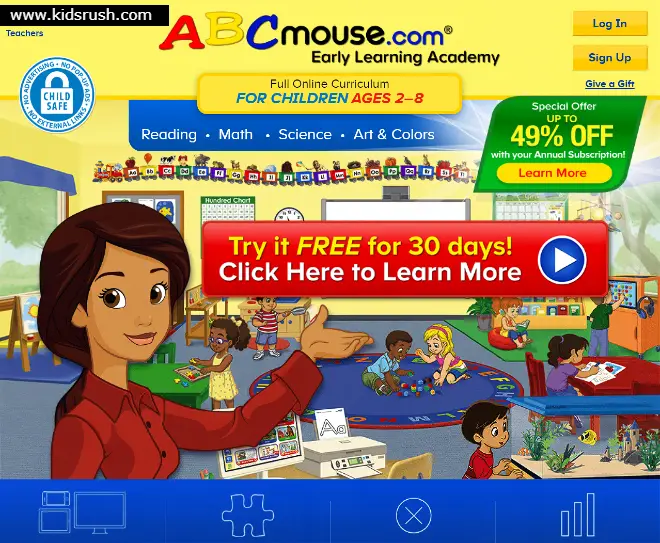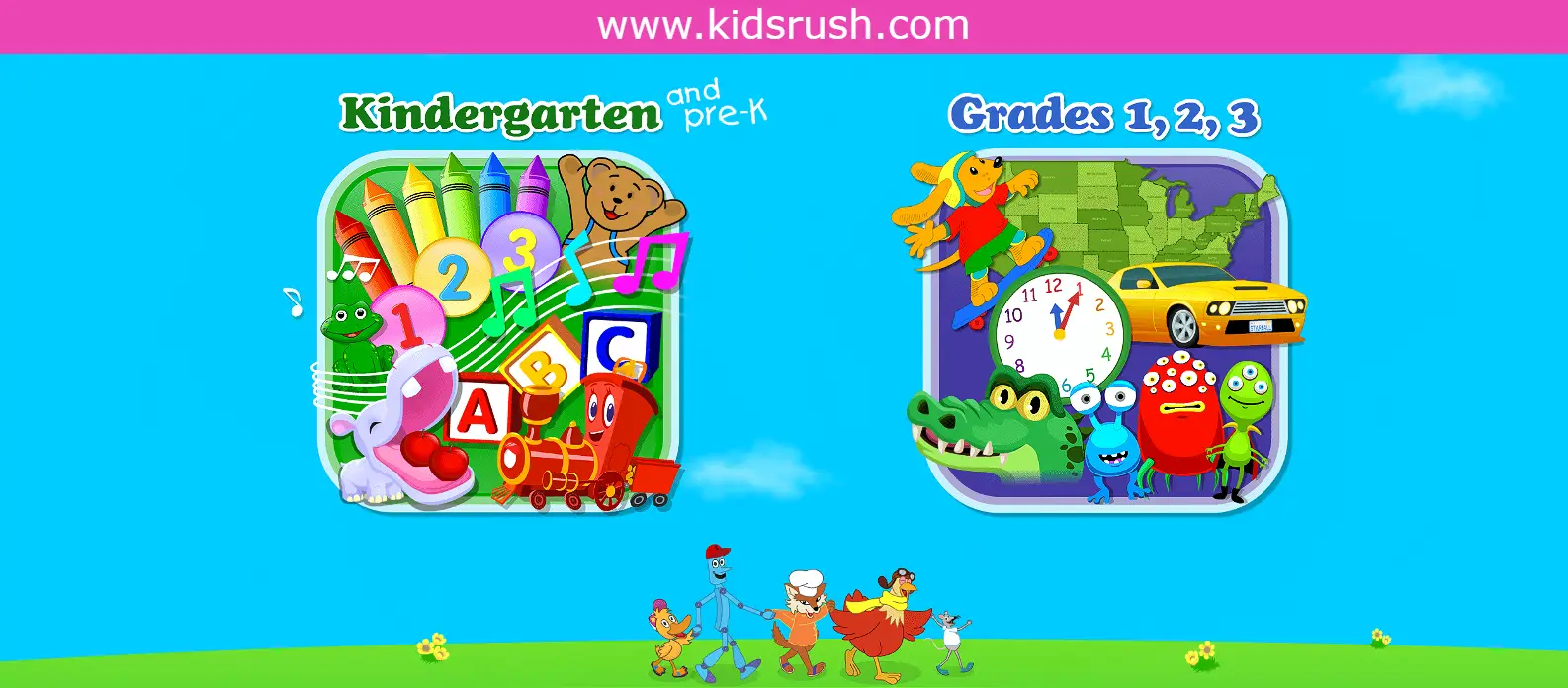It has been decades since literacy at-home lessons began. Now, students can learn to read with apps. Today’s toddlers don’t need workbooks or videotapes to have fun with their families; all they need is a tablet. The market is currently filled with dozens of apps, but a few are head and shoulders above the rest.
It’s possible to find a tool that meets your needs, from child-friendly tools to homeschooling tools.
List of Best Learn To Read Apps For Kids
ABCmouse: BEST OVERALL

ABCmouse has been a favorite for families with young children just starting to learn to read for a long time. Thousands of activities are available in the interactive app to help you develop this important skill.
In addition to Adventure Academy, ABCmouse offers an easy-to-use program designed for children ages two to eight called Learn to Read. A total of 850 lessons are included in Step-by-Step Learning Paths to help kids learn to read using fun, colorful activities, and kids don’t have to search through lessons to find “the right one”: kids can simply “play” straight through the integrated lessons.
While you can try the app for free for 30 days, the price after that is around $10 a month. The annual subscription price for families is almost half off. In addition to exposing students to math, arts, and science at age-appropriate levels, the app is comprehensive. The ABCmouse program is a solid and reasonably priced option for young children. To read the full review of abcmouse.com, please visit A Review Of The Educational Website ABCmouse.com.
Related: 11 Best and Free Math Sites for Kids: Websites for Students to Learn Math
Starfall: BEST FREE
Previously only available on web-based programs, the “learn to read” app now offers much of the same content for free (most of it is $35/year). Its curriculum has now been converted to an app format by Starfall, a non-profit that teaches reading on its website since 2002.
The book guides young children through their introduction to phonics, starting with simple examples and vowel sounds. In addition to reading sessions, the game section provides kids with fun games and activities that will help reinforce learning in a way that won’t feel like they’re “learning” at all.
The lessons teach a variety of sounds or language skills, with each one featuring a charming animal character. Starfall can be used after kids take phonics or alphabet lessons, so they don’t have to stop using it.
Students in elementary school can also choose from “Let’s Read,” which gradually increases the difficulty level, allowing them to continue improving their language abilities. They are introduced not only to fables, myths, nonfiction, and other types of literature at the most advanced levels but also to fables and mythology.
Homer: BEST FOR ELEMENTARY SCHOOL
Homer appeals to kids ages 2 through 8 (specifically, ages 2 through 8).
This app learning plans to each student’s requirements rather than providing them with a fixed curriculum. As the system progresses, students begin with a basic letter and number recognition. A customized learning plan is created for each child based on a combination of their favorite topics with their reading needs.
Kids will engage and remain interested in Homer’s game-like interface, just like other kid-centric reading apps. The app offers two options for users: proceeding through the lesson plans created by the app, or practicing the lessons, allowing students to repeat activities or practice concepts until they are completely mastery. Compared to similar apps, it is an affordable app: about $10 monthly after a free trial, or approximately $60 annually.
Read Also: The Most Beneficial Science Websites for Elementary Students
Hooked on Phonics: BEST FOR HOMESCHOOLERS
With its integrated system, Hooked on Phonics is one of the most popular brands for homeschooling children to learn to read.
In the pre-internet days, the company used primarily printed materials, such as books, flashcards, and worksheets for its learning materials. With the advent of multimedia learning platforms, it is still possible to teach kids to read with tried-and-true techniques but with a wide range of interactive options.
Subscribers to Learn to Read receive the app as part of their subscription package. Along with workbooks, they get books to read, activities, and questions to complete. Every new concept is introduced in a fun way, using a series of activities, videos, and even songs. Afterward, kids can practice their reading skills by engaging in interactive games and puzzles.
In addition, there is a built-in reward system that encourages more success. As a result, the system doesn’t offer the same level of features as other apps ($16 per month after a $1 trial) but it includes more than just the app for that price point.
Reading Raven: BEST FOR BASICS
Reading Raven is a free interactive app that teaches kids the basics of reading as well as how to love it when they age 3 to 7. It’s a phonics-based curriculum that starts with interactive games teaching kids to recognize and trace letters.
A bonus is that other skills such as hand-eye coordination, listening, and reading are developed as well. Building a solid foundation for reading comprehension from the beginning is a multifaceted process.
Children can customize their learning experience by selecting which adventures they want to take. 3-year-olds, for example, can play games focused on letter sounds and progress to word matches, whereas 5-year-olds may enjoy an activity focused on putting words together.
Each student can practice or play whatever they need or want. It’s all interactive and customizable. Apps with the same levels are usually $4, and the second volume is roughly $3. The original app costs $4, and the second volume has more activities.
Related: The 7 Best Science Websites for Kids
Skybrary: BEST SUPPLEMENTAL APPS
In addition to being affiliated with Reading Is Fundamental, a major non-profit organization committed to children’s literacy, Skybrary, formerly known as Reading Rainbow, has the advantage of being a branded brand within the SkyBrary brand.
A playful framework in which young readers can explore topics of their choice will enable them to establish an interactive digital library. The site includes a wide variety of children’s books that have been curated by experts, as well as supplementary video adventures and narrated read-along options. You can add books your kids will love to your reading lessons using Skybrary.
Kids in the app are given constant access to a wide variety of reading material, rather than technical instructions. Additionally, the app’s variety will help foster a true love of reading among young readers based on what they’re interested in, and that will come in handy regardless of the level of a reader’s actual skills.
An annual subscription costs about $40, or $5 per month. There are “in-app purchases” in the app, which indicates that the app is listed as “free.”
Related: What Are The Eight Best Educational Apps For Kids In 2021?
FarFaria: BEST FOR MEMBERSHIPS
FarFaria features a charming setup that is both suited to young readers and easy to follow. A magical map offers readers the opportunity to explore various topics and themes while increasing their reading speed.
Reading skills are taught in practical contexts rather than through full-fledged games or structured lessons, giving readers more control over what they read. Readers can read the books themselves or have them read aloud by professional narrators using the “read to me” option.
A free and a paid membership are available to FarFaria members. With the free plan, users get one new story per day, but with the paid plan, users get unlimited stories, plus a weekly new story and the ability to access favorite stories when not online.
A monthly subscription costs approximately $5 per month, a yearly subscription costs approximately $50 per year, and a lifetime subscription costs approximately $100. With access to new stories, regardless of your budget, it is possible for your child to love reading.
Related: 16 Fun and Free Educational Websites for Kids
FAQs
Learn to Read Apps: What Are They?
There is an increasing number of mobile apps designed specifically to teach young readers how to read. These apps are typically meant for children, so they differ from language learning apps designed for adults (who need to learn to read a language after they have studied it for a while). Children can practice curated reading selections and games while being introduced to basic concepts. They introduce basic concepts and gradually increase in difficulty.
Learning to Read Apps: How Much do They Cost?
The price range of learn-to-read apps is similar to most other learning apps. Most of them charge a monthly subscription fee between $8 and $13, while some are free. Apps that allow one-time purchases may also require additional downloads for additional content. Some are even free, ranging from completely free applications to “tiers” of free apps. No matter your price point, there’s an app that can work for you.
What features are available in Learn to Read Apps?
There are some features that most English-speaking children’s learn-to-read apps have in common, even if every app is a little different. Children tend to prefer cartoon-style apps, which tend to incorporate colorful activities and “games” for introducing basic concepts to them. Some apps will eventually read longer texts or offer a library of short stories so users can practice reading.
The degree to which an individual has control over the student’s journey may be one way apps differ. Several apps offer automatic navigation between lessons, while others have a more “choose your own adventure” approach. Even those that are pre-set usually contain a ‘practice’ feature, in which students may focus on what they need.
Additionally, there are apps geared towards practice, providing a constant flow of content for families and kids to practice with. Children should be taught to read, but also to love reading.
Our Picks for the Best Learn to Read Apps
A journey to learn to read is very personal, but it’s one that every family will need to take at some point, and parents should be as involved as a classroom teacher.
In choosing our picks, we made sure that the best-reviewed options were included. And for the most part, we went with well-known, tried-and-true names like ABCmouse, Hooked on Phonics, and so on. Besides providing more general categories, we also made sure to include specific categories for groups of learners that may need something more specialized, such as homeschoolers and the younger set.
As part of our focus, we’ve also designed apps that give students more control over their own teaching, whether by giving students access to “practice” modules that are not linked to lessons or by giving students access to libraries of books that they may explore at their own pace.
Several of the apps here are useful for students from different grade levels as well; even those designed for the very youngest learners have related apps or alternate modules that allow students to continue to learn through the same program over a period of time.


